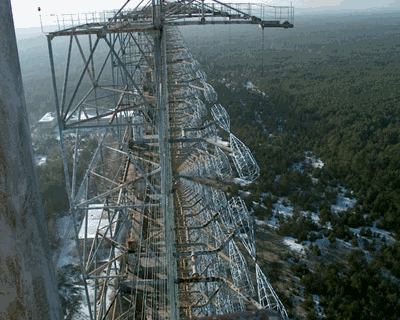K5LAD - 50+ Years of Ham Radio Memories
Volume XVIII
Who’s that knocking……………. A woodpecker? by Jim – K5LADHams who were active on the HF bands during the 1970s and 80s are very familiar with "the woodpecker" on their radios. The woodpecker appeared suddenly and without prior notice and really played "heck" with the ham bands back then. The source of this noise was the cause for many different theories because it did not seem to be transmitting on a particular frequency and seemed to be very elusive to hams and some commercial stations alike. It was some weeks from the first time it was heard, that the source was first suspected and later identified. The sound of the signal was completely unlike anything we had previously heard on our equipment.
Actually it was identified as coming from somewhere in Russia and was identified as an "over-the-horizon radar" signal. Regular radar, first used during World War II was originally on what we would call VHF frequencies but as it was quickly developed and improved and was moved higher and higher in frequency. Radar is essentially a line-of-sight system, which gives effectiveness but does limit the distance and range of the radar’s usage. It’s a bit like the bumper sticker often seen on large 18 wheeler trucks which says, "If you can’t see my mirrors, I can’t see you." Regular radar antennas, if raised in elevation, can see for quite some distance but can only see as far as the signal can travel in a line-of-sight. These signals are hampered by the horizon due to the shape of the Earth." (I’m assuming, here, that the reader subscribes to the established fact that the Earth is round. If you’re a member of ‘The Flat Earth Society’ perhaps you’ll want to move on to another article)
The Russian engineers had been experimenting with extremely high-powered radar signals that were being transmitted on the lower frequency bands. These signals were reflected by various layers; just as ham signals are reflected (if we’re lucky). The 20 meter ham band seemed to take the brunt of the destructive signal but it was also possible to hear this signal on bands both above and below 20 meters. The signal seemed to quickly drift or move around over a wide range of frequencies and cause much damage to the usefulness of several ham bands.
The "over-the-horizon radar" signal was, of course the Russian government’s attempt to watch for American missile attacks. The extension of the line-of-sight range would give them a tremendous time advantage should a missile attack occur. Because of this, they didn’t care whether we liked it or not.
The nickname "the woodpecker" was given to the noise because the noise most closely imitated the sound of a woodpecker outside your house and tapping on your door, or in this case, tapping on your receiver. The taps, which were from one to 5 per second, were so powerful that they totally assaulted the AGC (automatic gain control) of a regular ham-band receiver. Thousands of QSOs were assaulted and ultimately prematurely terminated due to this obnoxious interfering signal. It was later learned that they were using transmitters running millions of watts into massive antennas having immense gains.
Once the source had been identified, there followed several years of discussions between numerous governments, including the United States, and the Russian government. The discussions included nice requests, not so nice requests, threats, and all sorts of diplomatic attempts but the woodpecker interference continued. Sometimes the signals were less troublesome, sometimes they were so bad that the bands were unusable but they continued for years. It was such a problem that several commercial transceivers, designed and manufactured during the 70s and 80s, had a specific position on their noise blanker that was tailored for elimination or reduction of the woodpecker signal. As I recall, even a few redesigned their noise blanker to be especially for the woodpecker. Some of these circuits were more effective than others. The woodpecker interference signal had a different timing sequence from other types of noise so the blanker had to be designed for just that sequence to be effective against it.

It was later learned that the primary transmitting and receiving site for this radar system was near the Russian city of Chernobyl and when that area had a bit of a problem with their near-by nuclear reactor; much, actually most, of the local activities were terminated or moved. A Google search of information on the woodpecker will yield some interesting stories and pictures of the original facility. The picture is one showing part of the massive antenna site used to transmit the woodpecker signal. The cage-looking pieces are parts of thick dipole elements used to cover wide ranges of frequencies as it moved around.
One of the quickest ways to invoke an angry reaction from an HF-operating ham from the 1970s and 1980s is to innocently ask them, "Hey, do you remember the woodpecker from the ham bands twenty or thirty years ago?" It is highly recommended that before you ask that question that you either have a good bit of real estate between you and who you’re asking or else to be wearing your fastest Nikes.
Written August 29, 2009 Updated May 4, 2011
Page visited 532 times
Return to the Home Page